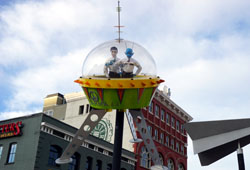
In 1998, Zurich was overrun by cows, as was the city of Chicago the following year. Toronto was invaded by moose in 2000 while Pittsburgh was a virtual Jurassic Park in 2003, with over 100 dinosaurs spotted around the Steel City.
None of these animals and giant lizards were living creatures but large sculptures that were part of public art exhibits within their respective communities. Although not associated with the trend that began in Switzerland, Salt Lake City started its own public art program in 2005 entitled “Flying Objects,” in which specially created sculptures were placed at key locales throughout the region, looking down on the city in a variety of shapes, sizes, and configurations.
The first Flying Objects exhibit was sponsored by the Salt Lake City Arts Council. Twelve artists were commissioned to construct a flying object that could withstand wind, rain, and snow for approximately two years. The completed sculptures were then raised on poles in three key locales around the city – across from Abravanel Hall, Capital Theater, and the Rose Wagner Performing Arts Center. Flying Objects was such a success that a second and third edition followed shortly thereafter, with version 4.0 launching in 2014.
Despite the name, the majority of the Flying Objects are not necessarily of the “unidentified” variety but instead an assortment of airplanes, birds, and even bees hovering around a giant metal hive. “Whimsical” has been the key word in describing Flying Objects by both the Salt Lake City Arts Council and local media, as well as residents of the region.
“We want to show that downtown is alive and well,” Nancy Boskoff, former executive director of the Council, explained to the Caspar Star Tribune in June 2006. “It’s something positive.”
Arguably the most popular sculpture of the first Flying Objects exhibit – as well as the creation that best exemplified the “whimsical” nature of the project – was Michael J. Bingham’s Cow-A-Bunga, which featured a cow flying over a crescent moon with a jet pack strapped to its back. The life-sized sculpture took Bingham over 1,000 hours to complete, weighed over 1,200 pounds, and was perched on a fifteen-foot pole in front of the Rose Wagner Performing Arts Center.
“I thought, ‘Those aren’t very aerodynamic animals, and they’re not likely ambitious enough to get airborne,’” Bingham told the Star Tribune about a herd of livestock he once observed. “For me, this is how the cow jumped over the moon,” he added, referring to the jetpack.
Michael Bingham returned to Flying Objects in 2014 with an equally ambitious creation entitled The Curious Voyager. Instead of an animal, Bingham chose an astronaut as the centerpiece for the sculpture – replete with a mirrored face mask – with the human space traveler floating upside down as he observes the streets of Salt Lake City below him.
“I’ll admit, I had just not too far back seen the movie Gravity and was really intrigued with that, with just the idea of weightlessness,” Bingham explained to the Herald Journal. “But that’s always been interesting to me. I’ve always been fascinated by astronauts.”
Brook Robertson’s Zion/Rocky Mountain Alliance, meanwhile, was likewise inspired by science fiction but stirred up a small level of controversy as well. The sculpture features two Mormon missionaries dressed in white shirts and ties inside a saucer-like craft, with one of the missionaries having blue-skin and antennas as opposed to appearing human. While at least one member of the Church of Jesus Christ of Latter-day Saints found the depiction to be offensive, Salt Lake City Arts Council executive director Karen Krieger took the controversy in stride.
“That’s the role of public art,” she told the Huffington Post. “To bring alive conversation in communities. Everybody interprets pieces differently.”
Exhibits like Flying Objects also provide opportunities for emerging artists who don’t always have options available to them. “Working your way into becoming a recognized artist is kind of like graduating from college,” Tim Littles, who participated in Flying Objects 3.0, explained to the Salt Lake City Weekly in 2010. “You have your degree, but no experience. Most galleries and shows want a resume with solo artist shows, group shows, gallery showings, awards and such. I am continually networking and working to improve my resume. One of the areas that I felt also added credibility to my resume was public art. I am a believer that public art is a much needed item in any city or town. It increases their credibility as an entity. I was impressed that Salt Lake is aware of the positives to displaying art publicly and wanted to be a part of it.”
According to former Salt Lake City Arts Council executive director Nancy Boskoff, both Utah in general and Salt Lake City in particular have vibrant arts scenes. “People are sometimes shocked by the quality and quantity in the arts in our state, particularly considering the size of the population,” she told Wild Rivers Review. “There has been a grand history of the arts here, starting of course with the Native Americans. When the pioneers came to settle, they included the arts early on and the Utah Arts Council was founded in 1899 by the Legislature, the first state arts agency in the country.”
If there is any doubt about the talent and vision of Utah-based artists, all one has to do is look up at the skies of Salt Lake City and imagine one of the many Flying Objects that dotted the skyline for well over a decade.
Anthony Letizia

